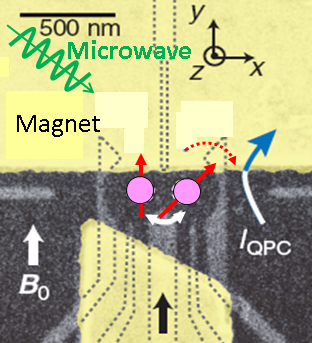Two-qubit gate of combined single spin rotation and inter-dot spin exchange in a double quantum dot, a useful technique for entanglement control

Researchers have studied various types of quantum element in the search for the components with which to implement quantum computation. Most promising among the candidates are semiconductor quantum dots (QDs) based on electron spin and highly-rated for their potential scalability. Single qubits, the smallest logical unit of a quantum circuit, have been realized by several groups around the world. In contrast, two-qubit gates, which operate on four computational basis states to control quantum entanglement and are essential for the construction of a set of universal quantum gates, have not yet been demonstrated for QD spin qubits.
Here, we demonstrate an electron spin-based all-electrical two-qubit gate consisting of single-spin rotations and interdot spin exchange in a double QD. A partially entangled output state is obtained by setting the two-qubit gate to an initial, uncorrelated state. We find that the degree of entanglement is controllable by the exchange operation time. The approach represents a key step towards the realization of a set of universal multiple-qubit gates necessary for quantum computation.
This research was carried out in collaboration with NTT Basic Research laboratories.
Press release (Japanese)
Paper
R. Brunner, Y.-S. Shin1, T. Obata, M. Pioro-Ladriere, T. Kubo, K. Yoshida, T. Taniyama, Y. Tokura, and S. Tarucha,
“Two-qubit gate of combined single spin rotation and inter-dots spin exchange in a double quantum dot”,
Physical Review Letters 107 (2011) doi: 10.1103/PhysRevLett.107.146801
Article link (Publication)







